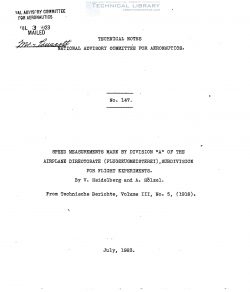naca-tn-147
- Version
- 201 Downloads
- 827.40 KB File Size
- 1 File Count
- November 3, 2016 Create Date
- November 3, 2016 Last Updated
National Advisory Committee for Aeronautics, Technical Notes - Speed Measurements Made by Division ''A'' of the Airplane Directorate (Flugzeugmeisterei), Subdivision for Flight Experiments

The various speeds of an airplane can only be measured in
horizontal flight, since there are no means for measuring
the angle of ascent or descent.
The measurements must be corrected for the density of the air.
This.isrobtained.by simultaneous pressure and temperature
measurements during flight.
Calculation from the mean yearly values in accordance with
Everling‘s suggestion (Technische Berichte, Vol. I, No.8)
can only be considered an approximation, since the distribur
tion of pressure and temperature in the individual strata at
different attitudes undergoes such large variations that the
yearly mean gives inaccurate values.
Thermographs of the present form are useless for temperature
measurements dn an airplane.
In altitude data, the following are to be distinguished: the
height above the earth, the barometric altitude and the alti—
tude corresponding to the yearly mean air density.
Speed measurements were made on seven different airplanes at
altitudes of 8500 to 4000 meters (8200 to 13100 feet), using
Iacoby's method (Technische Beriohte, Vblume II, No.1, p.99). with
theodolites from two fixed points. The base was 1.4 kilometers
(.87 mile) long. The effect of the wind was eliminated by a trianr
gular flight, each side of the triangle requiring about two minutes
flying time. The readings were taken about every 30 seconds or six
times on each leg. The airplanes carried the required useful load
for the flight.
The airplane speeds obtained were corrected for the density of
the air. For the sake of clearness, the altitude figures corre—
sponding to the yearly mean on the assumption of normal distribur
tion of pressure and temperature, are given in the tables and dia»
grams. The air densities were determined_in each flight from bar—
ograph curves regarded as pure pressure curves and from temperature
readings on alcohol thermometers. The readings of three thermome—
ters agreed closely.
| File | Action |
|---|---|
| naca-tn-147 Speed Measurements Made by Division ''A'' of the Airplane Directorate (Flugzeugmeisterei), Subdivision for Flight Experim.pdf | Download |
Comment On This Post